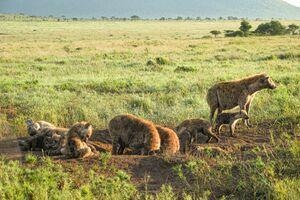Spotted hyenas adapt to a reduced presence of migratory prey in their areas triggered by climate change. This is the core finding of a study recently reported in the scientific journal Ecosphere.
 Hyenas at clan communal den in Tanzania. Image Credit: Sarah Benhaiem.
Hyenas at clan communal den in Tanzania. Image Credit: Sarah Benhaiem.
A group of scientists from the Leibniz Institute for Zoo and Wildlife Research (Leibniz-IZW), Germany, and the Centre for Functional and Evolutionary Ecology (CEFE), France, examined the association between volume of rainfall and migratory herbivore presence in hyena clan areas in the Serengeti National Park, Tanzania and the responses of lactating hyenas to recent variations in the climate-prey relationship.
Employing an observation-based dataset spanning 30 years, they demonstrated that the considerable increase in yearly rainfall during this time halved the incidence of migratory herds inside the hyena clan areas, but did not impact the ability of female hyenas to access their prey and effectively care for their young. This indicates a high plasticity of scavenging behavior of hyenas in reaction to shifting environmental circumstances.
It is fundamental to comprehend the mechanisms and extent to which animals in varied ecosystems are resistant to climate change. Changes in the amount or timing of precipitation can change the growth of vegetation and hence the scattering of migratory herbivores, such as the plains zebras (Equus quagga) and blue wildebeest (Connochaetes taurinus) in the Serengeti ecosystem in Tanzania, East Africa.
Climate change may therefore eventually affect the location of profitable feeding places for predators, like spotted hyenas, which prey on these herbivores.
A recent article shows that spotted hyenas (Crocuta crocuta) can modify their foraging behavior to changes in migratory prey presence in their areas that are connected to recent variations in the amount and pattern of rainfall.
Researchers from the Leibniz-IZW and CEFE examined data from a long-term project on three clans of spotted hyenas in the center of the Serengeti National Park. The three clans have been observed constantly from 1990 to 2019, almost on a daily basis.
Weather data illustrates that total yearly rainfall considerably increased in the Serengeti over these 30 years. At the same time, the presence of migratory herds in hyena clan areas basically halved.
To assess how the hyenas responded to these changes in rainfall patterns and prey abundance in their territories, we focused on maternal den attendance—the presence of lactating hyenas with entirely milk-dependent offspring at communal dens.
Morgane Gicquel, Study First Author and Doctoral Student, Leibniz-IZW
The researchers learned that, over a year, the likelihood of migratory herd presence in hyena clan areas increased with the amount of rainfall 2 months prior, and that the likelihood of maternal den presence in clan areas also improved with that of migratory herd presence.
As the volume of rainfall improved over the years, the existence of migratory herds in hyena clans reduced because the relationship between rainfall and herd presence became shaky. Remarkably, maternal den attendance did not decline during the whole study period and still matched times of high prey abundance.
“The presence of mothers at the communal den is a key behaviour directly related to cub survival. Spotted hyenas in the Serengeti National Park reproduce throughout the year. Their cubs entirely depend on milk for their first six months of life”, explain Dr. Marion East and Prof Heribert Hofer, senior researchers at the Leibniz-IZW who studied the hyenas in the Serengeti during the study period.
They added, “When large aggregations of migratory herbivores occur in the clan territory, all lactating mothers feed inside the territory and nurse their cubs daily. When migratory herds are absent, there is no other prey around and females fuel milk production by regularly commuting to distant areas to feed on migratory herbivores. After one to several days, they return to the communal dens to nurse their cubs.”
It could be anticipated that a drop in migratory herd presence within clan areas increases the time mothers spent away from their cubs hunting for prey. Thus, why did maternal den presence not decline in the hyena clans?
Our findings suggest that hyenas may not so much rely on an expectation of where aggregations of migratory herds should be on a given month, but rather employ other means of locating good foraging locations when commuting.
Dr. Sarah Benhaiem, Study Senior Author and Senior Scientist, Leibniz-IZW
A hyena might gather information on the ideal direction to depart on a traveling trip from the direction from which well-nourished clan members return to the den or the scent track left by these members. Earlier research by the Leibniz-IZW team had demonstrated that hyenas use deep-rooted traveling routes which cross several territories.
Dr. Sarah Benhaiem explains, “The use of these tracks would allow hyenas to obtain information on foraging success of animals from different clans they encounter on the way. This could help improve their efficiency in locating distant migratory herds.”
“Our results suggest that hyenas appear to be well suited to cope with changes in the presence of migratory herds in their territories induced by climate change”, says Morgane Gicquel.
This indicates a high plasticity in the response of this keystone predator to environmental variability.
Dr. Sarah Cubaynes, Study Co-Author and Scientist, CEFE
Though migratory herbivores in the Serengeti National Park are the key prey of many large carnivore species when they pass in their territories, only hyenas habitually travel long distances outside their clan area to prey on migratory herbivores. Nonetheless, the impact of potential variations in migratory herbivore movements might also influence other carnivores in this ecosystem.
Journal Reference:
Gicquel, M., et al. (2022) Climate change does not decouple interactions between a central place foraging predator and its migratory prey. Ecosphere. doi.org/10.1002/ecs2.4012.